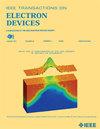A Novel Metal-Bridging Free Lift-Off Process for Fabricating High-Performance Sub-100-nm Gate Length MoS₂ Transistors
IF 2.9
2区 工程技术
Q2 ENGINEERING, ELECTRICAL & ELECTRONIC
引用次数: 0
Abstract
A novel approach for fabricating molybdenum disulfide (MoS2) transistors with sub-100-nm gate length is reported. Unlike the traditional lift-off process, the photoresist (PR) is not in contact with the MoS2 channel, while the metal deposited in the source/drain (S/D) areas is not bridged with that on PR through the PR sidewalls. A sacrificial oxide layer between the channel and the PR enables the two distinct features, which are done after generating the PR pattern that defines the S/D regions, selectively removing the sacrificial oxide to suspend the PR between the source and drain regions. When metal is subsequently deposited, the metal on the PR will naturally disconnect from that in the S/D regions due to the air gap between the PR and the channel. The new metal-bridging-free process frees the fabricated devices from many issues encountered in the traditional lift-off process. Besides, we combined the I-line photolithography and a novel PR trimming technique to demonstrate the feasibility of this approach in fabricating nanometer-scaled devices with high throughput. The fabricated MoS2 transistors with Au contacts exhibit S/D series resistance of 2.4 k用于制造高性能亚 100 纳米栅极长度 MoS₂晶体管的新型无金属桥接提升工艺
本文章由计算机程序翻译,如有差异,请以英文原文为准。
求助全文
约1分钟内获得全文
求助全文
来源期刊

IEEE Transactions on Electron Devices
工程技术-工程:电子与电气
CiteScore
5.80
自引率
16.10%
发文量
937
审稿时长
3.8 months
期刊介绍:
IEEE Transactions on Electron Devices publishes original and significant contributions relating to the theory, modeling, design, performance and reliability of electron and ion integrated circuit devices and interconnects, involving insulators, metals, organic materials, micro-plasmas, semiconductors, quantum-effect structures, vacuum devices, and emerging materials with applications in bioelectronics, biomedical electronics, computation, communications, displays, microelectromechanics, imaging, micro-actuators, nanoelectronics, optoelectronics, photovoltaics, power ICs and micro-sensors. Tutorial and review papers on these subjects are also published and occasional special issues appear to present a collection of papers which treat particular areas in more depth and breadth.
 求助内容:
求助内容: 应助结果提醒方式:
应助结果提醒方式:


